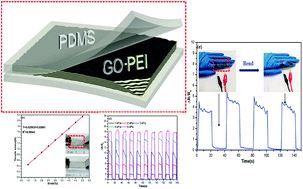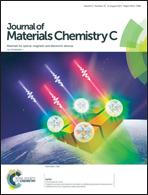A wearable and highly sensitive strain sensor based on a polyethylenimine–rGO layered nanocomposite thin film
Abstract
In recent years, graphene has attracted enormous attention and has been utilized in the investigation of flexible strain sensors due to its prominent mechanical and electrical properties. In this paper, the naturally viscous material polyethylenimine (PEI) and reduced graphene oxide (rGO) were used to fabricate flexible strain sensors by facile chemical layer-by-layer self-assembly (CLS) and thermal reduction methods. The morphology, spectroscopy and thermal properties of the as-prepared sensing films were measured by SEM, AFM, FTIR and TGA. The influences of GO solution concentration and PEI–GO bilayer number on the sensing performance were studied. The optimal sensor obtained a remarkable performance with a high gauge factor (754 under 5% stretch deformation) and an ultralow limit of detection (0.1% strain). A linear relationship between the normalized response of the sensors and the stretch deformation was observed in the low strain range. The proposed sensor achieved durable properties after 500 stretching–relaxing cycles and could work and withstand a strain up to 50%. Moreover, the proposed sensor was able to detect the subtle motion of a knuckle. This research proposed a facile strategy for the large-scale fabrication of a flexible strain sensor with high sensitivity and excellent repeatability.



 Please wait while we load your content...
Please wait while we load your content...